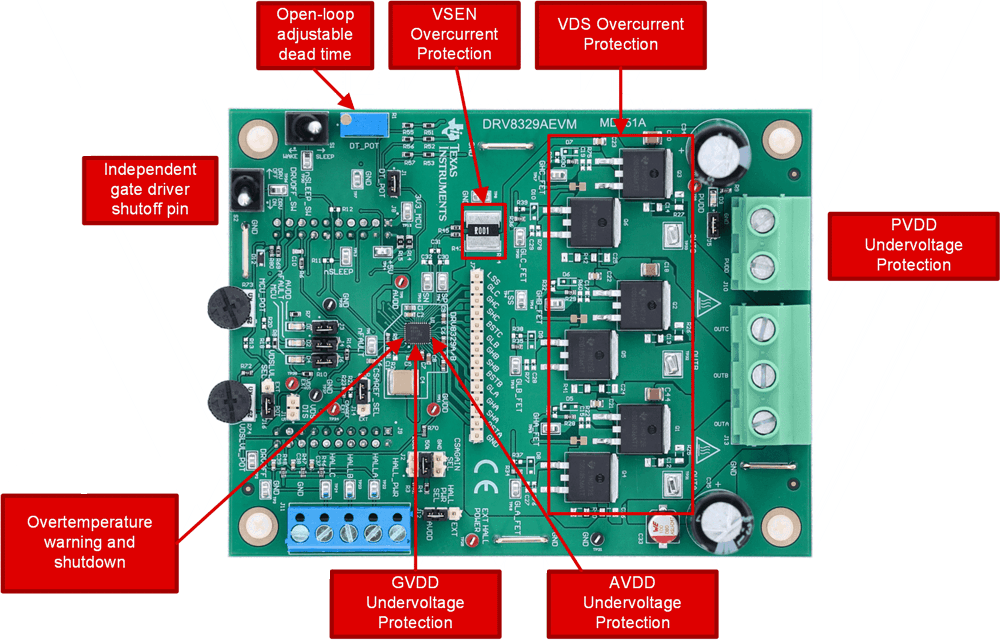-
Power Delivery in Cordless Power Tools Using DRV8329
Power Delivery in Cordless Power Tools Using DRV8329
Abstract
Cordless power tools require a small form factor and power stage to deliver up to hundreds of amps to the motor. High-performance tools, such as drills, require robust system performance powered from many types of high-quality and entry-level battery packs used across power tool platforms. To provide high torque, power tools require varying amounts of current which can deplete the battery voltage during stall conditions.
The DRV8329, a 3-phase BLDC gate driver, can help address these challenges through its hybrid bootstrap + trickle charge pump gate drive architecture to make it capable of providing at least 10V of gate-source voltage at low (~6V) supply voltages. In this application note, we will discuss how the DRV8329 meets application requirements for power tool platforms in various operating modes while also enabling system protection, consuming low quiescent current in sleep and standby modes, and maintaining a small form factor.
 Figure 1-1 Various Types of Cordless Power Tools Including Drills, Saws, Cutters, Grinders, Rotary Hammers, and Impact Drivers
Figure 1-1 Various Types of Cordless Power Tools Including Drills, Saws, Cutters, Grinders, Rotary Hammers, and Impact DriversTrademarks
All trademarks are the property of their respective owners.
1 DRV8329 Key Features
The DRV8329 is a bootstrap-based 3-phase Brushless-DC motor gate driver rated for 4.5V to 60V, and it is capable of driving 3 high-side and 3 low-side MOSFETs with up to 1-A peak source gate current and 2-A peak sink gate current. It uses a bootstrap-based architecture, which means 3 external bootstrap capacitors provide the voltage for the high-side gate driver outputs. In order to support up to 100% duty cycle, the DRV8329 includes a trickle charge pump in order to keep in the high-side MOSFETs fully on and deliver maximum motor current supported by the MOSFETs.
Furthermore, it uses a hardware interface for configuration and integrates a variety of features such as adjustable driver dead time and overcurrent threshold, an independent DRVOFF gate driver shutoff pin, current sense amplifier with low input offset and adjustable gain, a 3.3V 80-mA capable LDO, a 65-V tolerant sleep mode pin with <1uA sleep mode current, and multiple other protection features.
Available in a 36-pin, compact, 5x4mm QFN package, the DRV8329 is ideal for 2S to 10S power tool platforms with an absolute maximum rating of 65-V. This app brief showcases how the DRV8329 meets the most critical power tool requirements: performance, robustness, and scalability.
2 Power Tool Requirements
2.1 Performance
Power tools should have sufficient performance from no load to maximum load conditions. For instance, an 18-V cordless power drill in a no-load condition may spin at high speeds (up to 2000 RPM) while torque remains minimal. At a maximum load condition, the power drill may spin at very slow speeds or stall while supplying high torque (up to 1200 lb-in). Regardless of the load conditions, the Brushless-DC motor needs to deliver the required power to the mechanical load by commutating the motor with a sufficient Brushless-DC gate driver and power stage.
Because the Brushless-DC motor in a power tool can deliver kilowatts of power, the power stage is designed to deliver up to several hundred amps of current. This requires using N-type power MOSFETs that have large gate-to-drain charges (QGD), continuous drain current ratings (ID), and voltage overhead for motor transients (VDS). In order to drive six power MOSFETs or 12 parallel MOSFETs, the DRV8329 reliably supports at least 10-V of gate-to-source voltage across 2S to 10S operating range to fully saturate the MOSFETs with up to 1-A peak source and 2-A peak sink gate currents. Additionally, the DRV8329 provides 100% duty cycle support to efficiently switch motor current and deliver large amounts of power to the BLDC motor.
2.2 Robustness
In addition to delivering large amounts of torque, the system needs to be protected from unforeseen effects due to external load conditions, PCB parasitics, ambient temperatures, or materials such as dust. Problems that can occur during power tool operation include overcurrent conditions, motor undervoltage, supply undervoltage, or overtemperature. A well-designed PCB layout can combat many of the most frequently faced issues during evaluation, but a suitable BLDC gate driver should be prepared to disable the gate driver circuits quickly if a fault occurs. As tools continue to have high standards of quality and performance, it also is important that backup forms of protection exist, such as redundant device protection features and external circuits to shutoff the gate drivers or disconnect the supply.
The DRV8329 includes two forms of overcurrent protection to protect the power stage from short-circuit conditions: VDS (MOSFET drain-to-source voltage) and VSEN (sense resistor voltage) overcurrent protection. VDS overcurrent protection is set by an analog VDSLVL input voltage to control the overcurrent threshold across the high- and low-side MOSFETs, and VSEN overcurrent protection is a fixed 0.5 V threshold across the sense resistor from the low-side MOSFETs to the motor ground.
Additionally, the DRV8329 integrates an adjustable open-loop dead time to prevent against shoot-through conditions and reduce software-related complexities. To protect against undervoltage conditions, the DRV8329 implements supply, bootstrap, gate drive voltage, and LDO undervoltage lockouts so that there is sufficient voltage to power the gate driver and/or external circuits.
 Figure 2-2 Protections Implemented on the DRV8329AEVM Applicable for Power Tools
Figure 2-2 Protections Implemented on the DRV8329AEVM Applicable for Power Tools